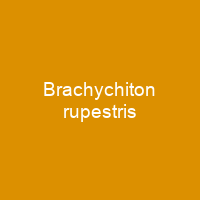Brachychiton rupestris: The Queensland Bottle Tree
Imagine a tree that can store water like a bottle—how cool is that? That’s exactly what the Queensland bottle tree, or Brachychiton rupestris, does. This deciduous wonder is native to the dry regions of Queensland, Australia, and has a fascinating way of surviving harsh conditions.
Structure and Appearance
The Queensland bottle tree stands out with its bulbous trunk that can grow up to 3.5 meters in diameter, making it look like a giant water storage container. This unique feature helps the tree survive droughts by storing water within its thick bark. Can you imagine how much water this tree could hold? It’s like having a natural reservoir right in your backyard!
Leaves and Flowers
The leaves of Brachychiton rupestris are simple or divided, with narrow leaf blades that can grow up to 11 centimeters long. These leaves are not just for show; they play a crucial role in the tree’s survival by reducing water loss during dry periods. The creamy-yellow flowers appear from September to November, adding a splash of color to the landscape. Each panicle contains 10–30 flowers, each measuring 0.5–1 cm long and 1.3–1.8 cm wide. These flowers are not just pretty; they attract pollinators like insects, ensuring the tree’s survival.
Life Cycle and Reproduction
The Queensland bottle tree undergoes a fascinating life cycle. From November to May, groups of 3 to 5 woody follicles develop, each containing 4 to 12 seeds. The seeds are ovoid with a smooth surface, measuring 6–7 mm in length. These seeds are crucial for the tree’s propagation and survival.
Propagation can be challenging due to irritating hairs on the leaves, but it is not impossible. Seed-grown bottle trees may take up to 20 years to flower after adult leaves appear. This long wait makes careful cultivation essential. Alternatively, stem cuttings from semi-mature growth treated with rooting hormones and bottom heat can also be used for propagation.
Conservation Status
The Queensland bottle tree is classified as “Least concern” under Queensland’s Nature Conservation Act. However, it faces threats in its natural habitat due to declining range and endangered ecosystems like the semi-evergreen vine thickets of the Brigalow Belt (North and South) and Nandewar bioregions.
Ecology and Uses
The Queensland bottle tree plays a vital role in its ecosystem. It is a host plant for mistletoe species Dendrophthoe glabrescens, providing food and shelter to various insects like the pale cotton stainer bug and kurrajong leaf roller caterpillar. Additionally, it serves as habitat for the near-threatened black-breasted buttonquail.
Bushfire resistance is another remarkable trait of this tree. After a fire, it responds by flowering and producing new foliage, ensuring its survival in harsh conditions. Its ability to withstand fires makes it an invaluable asset in areas prone to wildfires.
Aboriginal Uses
The Queensland bottle tree has been used by Aboriginal people for centuries. The roots can be eaten raw or cooked, providing a source of food during times of scarcity. Trunk wounds secrete a sticky substance that was used as glue and in making nets. Leaves were also used as fodder for livestock, and in drought conditions, the whole tree could be felled to provide feed stock.
Cultivation
Today, the Queensland bottle tree is commonly planted in streets, parks, farms, and gardens due to its aesthetic appeal and hardiness. It thrives in climates equivalent to USDA hardiness zones 9 to 12. Mature trees can transplant easily and withstand up to three months without replanting.
Propagation from seed requires care due to the irritating hairs on the leaves. However, stem cuttings from semi-mature growth treated with rooting hormones and bottom heat offer a more controlled method of propagation.

The Queensland bottle tree is a remarkable example of nature’s ingenuity. Its ability to store water, adapt to harsh conditions, and provide resources for both wildlife and humans makes it an invaluable species in the Australian landscape. As we continue to face environmental challenges, understanding and preserving such resilient plants becomes more crucial than ever.
You want to know more about Brachychiton rupestris?
This page is based on the article Brachychiton rupestris published in Wikipedia (retrieved on November 27, 2024) and was automatically summarized using artificial intelligence.







